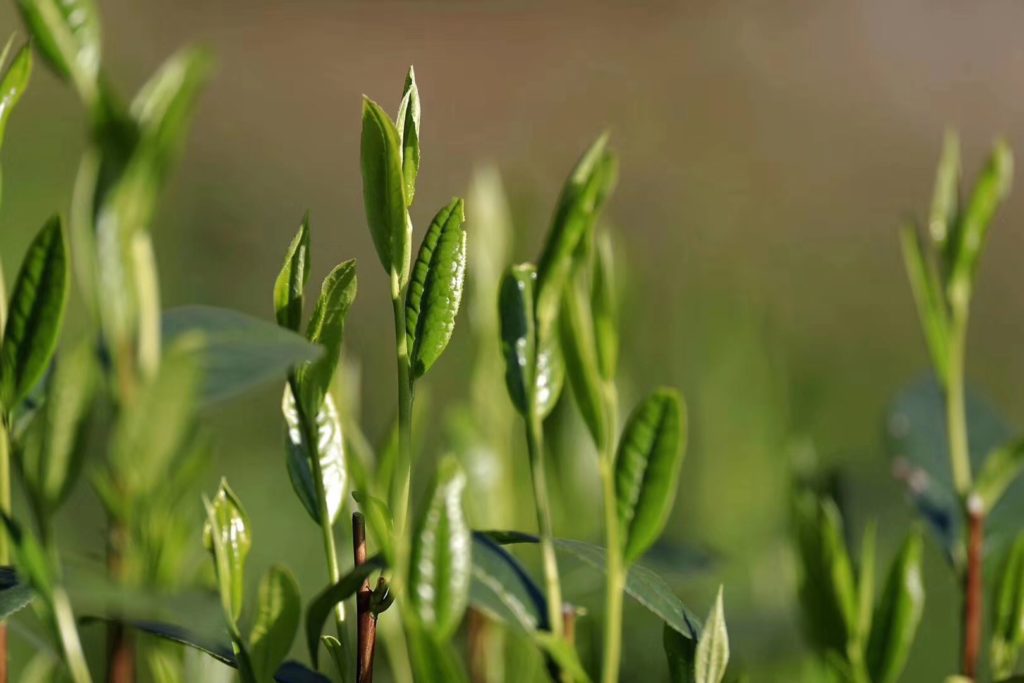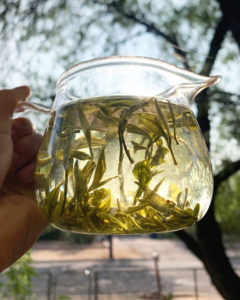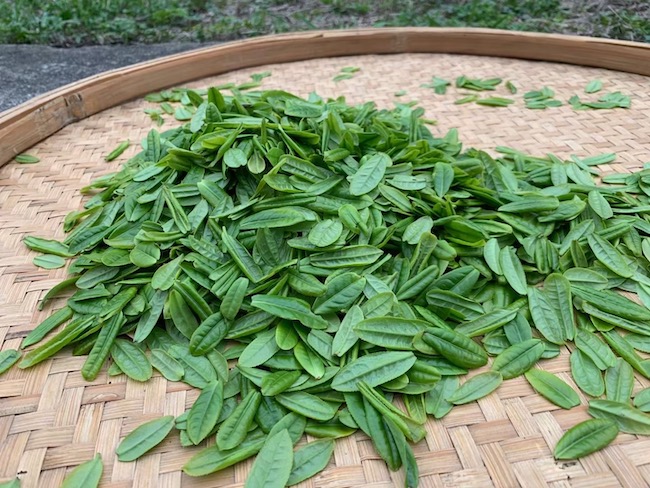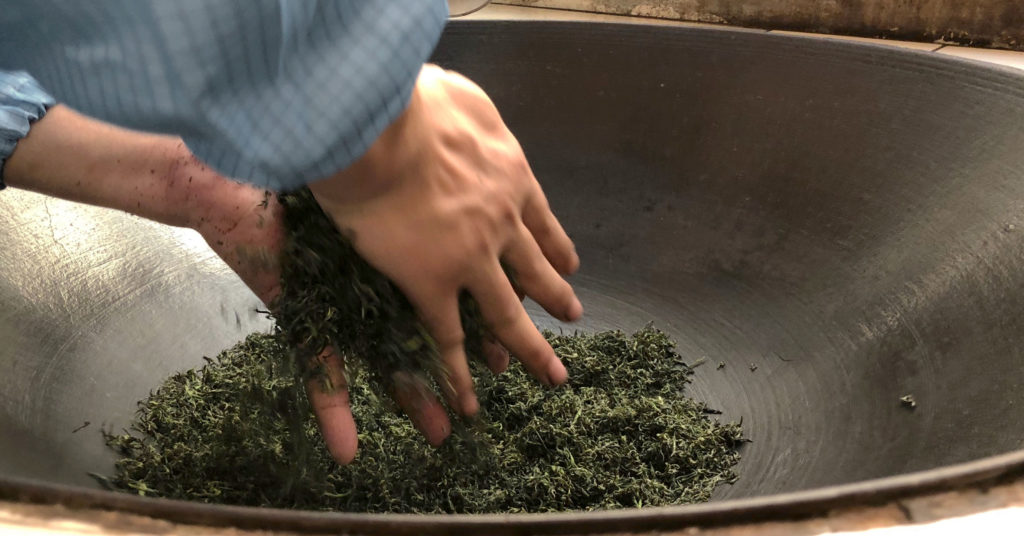
History
Before there was any other tea, there was green tea, and the health benefits of green tea date back more than 5000 years. Green tea is regarded in China as the ultimate tea, and there are thousands of different varieties, plus many more from all around the world. However, the original Chinese teas are still rightly thought of as the finest. Green tea is made from the sweetest, newest buds and tips plucked from the top of the plant, and the best varieties are only harvested in the spring. Unlike black, oolong and puer teas, green tea is not fermented (or oxidized). What makes green tea different from other teas is what leaves are chosen, how and when they are plucked, and how they are then processed. There was a time when spring could not officially be declared until the very first tea was delivered to the emperor. Today it is still true that the most prized green tea are the first tender buds of spring. In fact, there was a time when green tea was commonly worth more than gold. Still in China, Japan, and Korea, it remains the best gift that you can give someone to whom you wish to show respect by wishing them a long life
One of the most studied teas
Green tea is gaining popularity quickly because of the health benefits being verified by an avalanche of scientific research, the bulk of which being focused on green tea. Of course, that green tea is good for your health is not news to the people of China and Japan, and it doesn’t necessarily mean that green tea is better for you than any other kind of tea, but just that more research is being done with green tea. The Japanese started it off about thirty years ago when they started wondering why people in Okinawa lived so long and had such a low occurrence of cancer. Cancer has historically been the focus of a lot of the research, but lately green tea has been found to have properties that also have an impact on heart disease and diabetes, and a whole list of other health issues, and the list keeps growing.
What is EGCG?

What has been studied with intense focus are the tea polyphenols that are such powerful antioxidants, EGCG (Epigallocatechin gallate) in particular, the concentrations of which being highest in the very young unopened leaf, known as a bud, or tip. EGCG appears to be very powerful in the prevention and treatment of various cancers. In Chinese medicine green tea is thought to be effective as a cooling agent for treating diseases characterized by having too much internal heat, inflammation for example. More oxidized tea, like oolongs and black tea, is known as being good for warming. The general rule is the less oxidized, the more cooling, and green tea is not oxidized at all. The Chinese believe the better the quality tea, the better the nutrition. In the West, we want to break things down into individual parts and isolate the nutrients that we can make into medication and market the extracted nutrient. With green tea, it should be taken in its undivided form because the combination of all the nutrients working together the creates the maximum impact on your health.
More about green tea’s history
Even though it is impossible to exactly determine the point in time when the actual process for making green tea was discovered, tea as an herb dates back nearly five thousand years to the Emperor Shennong, who is credited with the discovery of tea, and the discovery of Chinese medicine for that matter. Green tea by definition is tea that has been heated in some way after picking to stop the oxidation of the leaf, and then dried in some way. Green tea had already been invented when Blacks and oolongs started to emerge about five hundred years ago, but prior to that, there was only green tea.
It isn’t well known that the British began their tea drinking with green tea, as did Americans and other Europeans. In China there is no tea above green tea. Prior to the Ming dynasty (1368-1644) all green tea was compressed into cakes. Loose leaf tea became popular during the Ming dynasty, and remains so today, although bricks and cakes are mostly produced in Sichuan and Yunnan. Sichuan primarily supplies Tibet and Mongolia, while that target market for Yunnan compressed tea (puer) is Guangzhou and Hong Kong, and lately the rest of the mainland and Taiwan.
Even though tea consumption dates back at least five thousand years, Camellia sinensis small leaf Chinese tea, was first cultivated in the mountains of Sichuan, and Meng Ding Shan in particular. The first tea garden was credited to Wu Li Zhen. The dating of his gardens is made possible not by its having had tea bushes that old, but because he also planted Ginkgo trees that have survived and are estimated to be 2200 years old. Chinese tea scholars have established that all tea originated in Yunnan. There is no clear documentation about the spread of tea from Yunnan to Sichuan, it is thought that because of the difference in weather between the two areas, Sichuan could be the source of the modern small leaf variety of tea. Yunnan is very sunny and produces a very big leaf tea, where as Ya’an county in Sichuan is almost continually overcast and rainy and the tea leafs are very small and delicate.
We don’t have a clear idea about the history of tea until the Tang Dynasty. Prior to that, there are primarily tribute records that were determined locally by in large; the tribute was determined by local authorities who decided what would be given to the emperor and what best demonstrated their best local wares. The Tang Dynasty was a golden age in China, and incorporated tea culture.
What do people mean by tribute tea?

In 770 the Emperor’s first tea factory was opened in the Guzhu valley just south of Tai Hu in Zhejiang province supervised by the ‘Tea Saint’, Lu Yu. Lu Yu mentions Ming Ding Shan teas, in Sichuan, as being the best tea. The factory was built in the East where the cultural movement was centered. Xian was the capital at the time and tea from all over China was sent to the Emperor as tribute. It was a requirement that the tea had to arrive in Xian before the agricultural season of Qing Ming which typically falls in early April. At that time tea was graded by when it arrived in Xian- the best arriving first and so on. To this date tea that is harvested before Qing Ming can be twice the price of tea harvested after. It may sound like it would be hard to tell the difference, from its taste alone, but the first growth of the year is very uniform in appearance and not to difficult to spot if you know what to look for. Color and sweetness change with the later growth because there is less amino acid.
Tea at that time was manufactured into cakes. The cakes had little in common with the cakes now produced in Yunnan. The tea was steamed first of all to stop the oxidation, and then they pressed it and ground it to extract moisture, and then pressed it into mold and baked it leaving a hole in the middle.
As tea making progressed from the Tang to the Song, the process became more complicated and the cakes became so valued they were being used as currency. During the Tang the favored areas for tea were from Sichuan down the Yangtze River Valley, but by the Song the tribute area had migrated south to Northern Fujian.
The prohibition of tea in cake form
As the Ming came into power, the use of tea cakes as currency it was causing instability in the monetary system. In September of 1391, the Emperor Ming Hong Wu outlawed the making of cakes, and ordered all cakes to be destroyed. This left the tea industry demolished and it did not fully recover for 150 years. Out of that period modern tea was invented- what we call loose leaf tea today, in all its variations and complexities. In the Huang Shan a technique consisting of frying, shaping, and baking was adopted, and this system quickly spread to Northern Fujian, not far away. In Zhejiang tea makers were developing a system for frying only. Out of these two techniques all modern tea making has evolved, starting with green tea and at the end of the Ming and throughout the Qing came oolongs, black tea, white tea, yellow tea. The techniques could be practiced on a smaller scale so big factories were not required, and the common people of China for the first time became tea drinkers. No longer was tea for just the noble and the rich, and now tea is the second most consumed beverage in the world after water. Green Tea is by far the most popular type of tea in China, Korea, and Japan.
How green tea is made
Green tea is defined by its lack of cellular oxidation. Far from monolithic – spread across every tea growing region in China are a myriad of cultivated varieties for green tea. Each has their own style of processing to suit them, with a multitude of leaf shapes in the finished product.

The picking process itself is an art form. The pickers very often begin their day before dawn on the eastern face of the mountain, shrouded in fog and mist. It is amazing to me that under those conditions that the tiny buds can be located, never mind that for some of those green teas there maybe anywhere from 75 to 150 thousand pluckings per kilo. The tea needs to be picked before the sun hits the leaves, which causes them to grow very quickly. There is only a window of 4 or 5 days when this choice grade of green tea is available.
So what makes green tea different from black tea?
So what is it that makes green tea green tea? It might surprise you to know that until the 1840’s Europeans thought that green tea and black tea came from different plants. What makes green tea green tea is how it is processed. The process of course starts with plucking. The youngest, most tender leaves provide the best quality. All of our green tea, with the exception of Sencha and Gunpowder, are hand picked. Hand picking is a very skilled job and increases the price of the tea. Most tea is harvested with a clipper developed by the Japanese that requires two people, one on each side of the row of bushes. The objective is just clip the very top of the bush. If you have seen pictures of tea gardens with beautifully uniform rows of bushes, it is a result of these clippers.
Processing
After the tea is picked it is allowed to wither. These leaves are stiff and need to soften for further processing; also these leaves don’t have much of a fragrance. The leaves are placed on bamboo trays and placed in the sun or on racks. The tea is allowed to wither for three or four hours until the tea master determines that the smell is just right and then it enters the next step- heating to remove moisture and prevent the leaf from oxidizing. There are many ways of doing this, with some of them being very complex. Long Jing, for example has ten different hand movements required of the tea maker. While he manipulates the tea in a big wok as the tea dries there are two basic methods, baking and frying. (There is no oil involved in the frying.) It is easy to tell which method was used, as the fried tea has a yellowish green color, while the roasted has a much darker color. It is interesting to note that the tea when brewed doesn’t have the variation of color that the dry tea has. It is much closer to the fresh leaf color however it is processed.

Important things to know about green tea
When buying green tea, look for whole unbroken leaves. Breaking the leaf causes bitterness. If you buy a tea that is a whole leaf green, you will have less trouble brewing your tea. There should be both briskness and sweetness in a good green tea. Remember also that fragrance is a very important aspect of good tea, especially in green tea. Pay attention as much to the smell as to the taste. Green tea has a shelf life of about eighteen months if stored properly and it should be stored in such a way as to keep it protected from humidity, light, oxygen, and heat. Some people put their green tea into their refrigerators. That is ok, but the tea should be allowed to warm to room temperature before it is opened so that the tea stays dry. Cold tea exposed to air will draw moisture out of the air and will condense on the leaves.
Judging the quality of your green tea

Leaves of Chinese green tea should appear even and unbroken, with good color, and slightly shiny with their natural oil. The dry leaf should have a noticeable fragrance. The brewed liquor of most good quality green teas maintains a vibrant color with good clarity. Quality green tea is often determined by the leaf configuration of the plucked tea. One bud, one bud and one leaf, or one bud and two leaves are usual leaf configurations of good quality green tea. The leaves when brewed should look exactly as the did when plucked. The color of the dry green tea can range from a light green to yellowish green for green tea that is primarily fried, to a dark green for green tea that is primarily baked.
Over the past two decades, green tea has emerged from obscurity in the western market. This trend, fueled by western studies into the health benefits of green tea has spurred a demand for better quality leaf.
